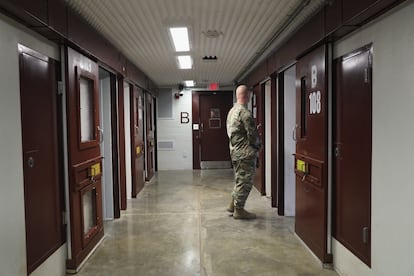Guantánamo: the torture legacy 21 years later
Thirty prisoners remain incarcerated at the U.S. Naval Base in Cuba, trapped in various types of legal limbo


The U.S. naval base at Guantánamo Bay has a movie-like feel to it. Entering it from the airport, on a ferry crossing the crystal-clear bay in a picture-postcard landscape, looks like a scene from White Lotus, enthusiastic welcome included. The residential area, with its baseball field, McDonald’s, Irish pub and outdoor movie theaters, could be a tropical version of the small provincial town in Back to the Future. But the roadblocks, checkpoints and constant military police patrols are a reminder that behind the fences there is another, much crueler reality.

Hidden from view, physically separated from the rest of the base, and all but forsaken in the news, the Guantánamo Bay prison, synonymous with some of the worst abuses of the U.S. war on terror, is still open 21 years later. Thirty elderly, physically and psychologically damaged Muslim men, a handful of them accused of some of the world’s worst attacks, continue to be held in this prison.
As many as 779 Muslim men were captured and secretly transferred, hooded and handcuffed, to this prison. Then President George W. Bush ordered its construction in reaction to the attacks of September 11, 2001, to house terrorist “enemy combatants” without the obligation to provide them with the safeguards that they would be entitled to as prisoners on U.S. soil. The vast majority of the inmates had nothing to do with those attacks, the Al Qaeda network, or Islamic terrorism. Many were sold to the CIA for a handful of dollars. Each, notes UN Special Rapporteur on Human Rights and Counterterrorism Fionnuala Ní Aolaín in her report on the prison published in June, “had or has their own distinct experiences of unrelenting psychological and physical trauma of withstanding profound human rights abuse.”
“Guantanamo is still open not because of what they did to us, but what we did to them”Mark Fallon, former chief investigator and witness
The fear of a sudden attack by Islamic terrorists on this corner of Cuba has faded. The boat patrols of soldiers armed with assault rifles that used to travel through its waters and were one of its most defining images have just been phased out. At this base, where some 6,000 people (soldiers and civilians) reside, 800 are currently working in prison-related jobs. Half as many as three years ago, but the figure reveals a ratio of almost 27 per prisoner.
The idea is to reduce it as much as possible, and eventually close a prison that, at a cost of US$13 million (€11.8 million) per prisoner, is the most expensive in the world. But nerves persist: no one is allowed to take pictures of the faces of any military personnel, nor of any kind of infrastructure. Many soldiers do not want people to know that they serve here.
“The name Guantánamo may forever remain synonymous with the systematic use of rendition, torture and arbitrary detention,” stated Ní Aolaín at a press conference in New York.
Camp X-Ray is a permanent reminder of everything that happened here. In the northwest of the base, it was the first prison to be built. It was put up in a hurry. The result: cages of barely two by two meters (six by six feet), in the open air, under the relentless Caribbean sun. Two buckets in each. One for water, one for feces. And nothing else in them. It was used for four months before the prisoners were moved to more permanent structures.
Today it is an abandoned camp, which the media — who must always be accompanied by a military escort — can only see from afar. Mosquitoes are the only torturers left; they still practice their art with viciousness. Weeds have been granted their freedom and grow everywhere with the rush of the tropics; snakes have infested the area with impunity. Thick barbed wire fences still enclose the different zones. The roofs of the guard turrets, the cells and interrogation rooms — “wooden boxes,” as described by Mark Fallon, a former Al Qaeda investigator in the most brutal era, who once reported torture to the authorities — are holding up precariously.

In the days when Camp X-Ray was operating, and for years after, it was not the desire for justice that drove the jailers. It was the anger following the deaths of more than 3,000 people in the 9/11 attacks. And the fear that a similar attack would occur somewhere in the world and no one would detect it in time. Poorly trained interrogators under enormous pressure completed the toxic mix.
The result was widespread use of torture. Waterboarding, beatings, extreme sleep deprivation, anal rape. Mark Fallon, then head of an investigative unit at Guantánamo, confirmed earlier this month the existence of a culture of abuse that had become widespread by the summer of 2002 among a military intelligence unit: efforts to induce a feeling of extreme disorientation, use of dogs to intimidate, forced stress positions. Sleep disruption was “routine within the camp,” this witness testified before the military court in a preliminary hearing — also in a confined area isolated from the rest of the base, Camp Justice — in the case of Abdelrahman al-Nashiri, suspected in the bombing of the destroyer USS Cole that killed 17 people and wounded nearly 40 in 2000 in waters off Yemen.
“Guantanamo is still open not because of what they did to us, but what we did to them,” Fallon told this newspaper. “And the government continues to try to hide, redact and classify anything that will lead to accountability of those who were involved in the torture program, as well as those who’ve advocated for it.”
Allegations about what was going on in those cells led then-presidential candidate Barack Obama to announce that closing the prison would be his first move in the White House. He never succeeded. His successor, Donald Trump, promised instead to fill it with “bad people.” He did not succeed either. Current President Joe Biden has also pledged to shut it down. So far, he has only been able to release ten inmates. The latest of these is Said bin Brahim bin Umran Bakush, transferred to Algeria in April. The remaining 30 are in various forms of legal limbo.
Only two of the 779 prisoners have been convicted and are serving their sentences at the base on Cuban soil. Along with them, three others are listed as “enemy combatants” and are nicknamed “eternal prisoners”: they will not be brought to trial and the United States does not want to release them, although their status is subject to periodic reviews. Another 16 have been authorized for transfer to a third country. The problem is finding one that wants to accept them. Nine are awaiting trials on their cases — the USS Cole bombing, 9/11, the Bali nightclub bombing — which were postponed during the pandemic. The cases are bogged down in appeal after appeal, never coming to fruition.
“This is a system that was set up not to have any of the safeguards I find would be in the American judicial system, or really even a military court. And it was done intentionally. It was decided that the hearings would be held at Guantánamo because they believed it was a place outside the protections of the Constitution,” explains Anthony Natale, head of the team of lawyers defending Al Nashiri. “Total over classification of information. They’re constantly trying to fight us from getting information. And so we’re litigating constantly, things which you would never have to litigate in a regular US court, or even in the US military. So that combined with the logistical distance to see to just get things done, is a perfect recipe for an unjust system.”
Aging prisoners and prisoners with health problems
Two decades after their arrival at Guantánamo, those 30 prisoners are now elderly, with physical and mental health problems, caused both by their age and the mistreatment they have suffered. These inmates, according to a senior official of the International Committee of the Red Cross, Patrick Hamilton, who visited the facilities in March, show signs of “accelerated aging, worsened by the cumulative effects of their experiences and years spent in detention.”
Conditions are no longer the same. Ní Aolaín admits that the current conditions, in terms of treatment, food, accommodation, and activities “meet internationally accepted standards for most detainees.” But concerns continue. “Arbitrariness seeps throughout Guantánamo’s detention infrastructure, making detainees vulnerable to human rights abuses and contributing to conditions, practices, and circumstances that lead to arbitrary detention,” the special rapporteur notes. Various procedures, such as referring to them by number and not by name, or the “disproportionate” use of solitary confinement, “constitute, at the very least, cruel, inhuman, and degrading treatment.”
It is difficult to foresee how the situation may be resolved in the future. Natale argues, “Our government says it wants to undertake the trials, but then doesn’t give the defense the evidence or the opportunity to challenge it. So, the reality is they don’t want to go to trial.” The reason, the lawyer says, is that “they want to hide the torture, and how systematic, how omnipresent, and horrible it was. There are things I can’t describe to you: they’re classified.”
As you leave Camp Justice, where preliminary hearings are held, and return to the center of the base, a yellow traffic sign reminds you that iguanas are a protected species. If one wants to cross the road, vehicles must let it pass. Causing the death of one of these lizards involves a fine of $10,000. “For a long time,” Fallon laughs bitterly, “here at Guantánamo the reptiles had more rights than the prisoners.”
Sign up for our weekly newsletter to get more English-language news coverage from EL PAÍS USA Edition
Tu suscripción se está usando en otro dispositivo
¿Quieres añadir otro usuario a tu suscripción?
Si continúas leyendo en este dispositivo, no se podrá leer en el otro.
FlechaTu suscripción se está usando en otro dispositivo y solo puedes acceder a EL PAÍS desde un dispositivo a la vez.
Si quieres compartir tu cuenta, cambia tu suscripción a la modalidad Premium, así podrás añadir otro usuario. Cada uno accederá con su propia cuenta de email, lo que os permitirá personalizar vuestra experiencia en EL PAÍS.
¿Tienes una suscripción de empresa? Accede aquí para contratar más cuentas.
En el caso de no saber quién está usando tu cuenta, te recomendamos cambiar tu contraseña aquí.
Si decides continuar compartiendo tu cuenta, este mensaje se mostrará en tu dispositivo y en el de la otra persona que está usando tu cuenta de forma indefinida, afectando a tu experiencia de lectura. Puedes consultar aquí los términos y condiciones de la suscripción digital.
More information
Archived In
Últimas noticias
The complicated life of Francesca Albanese: A rising figure in Italy but barred from every bank by Trump’s sanctions
Reinhard Genzel, Nobel laureate in physics: ‘One-minute videos will never give you the truth’
Pinochet’s victims grapple with José Antonio Kast’s rise in Chile
Half of Scotland is in the hands of 420 property owners
Most viewed
- Pablo Escobar’s hippos: A serious environmental problem, 40 years on
- Reinhard Genzel, Nobel laureate in physics: ‘One-minute videos will never give you the truth’
- Why we lost the habit of sleeping in two segments and how that changed our sense of time
- Charles Dubouloz, mountaineering star, retires at 36 with a farewell tour inspired by Walter Bonatti
- The Florida Keys tourist paradise is besieged by immigration agents: ‘We’ve never seen anything like this’










































